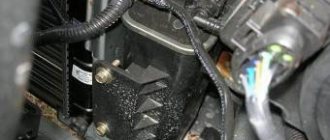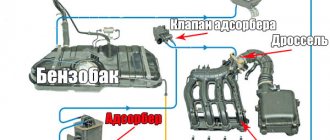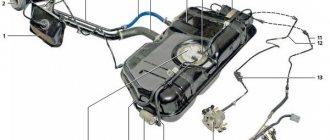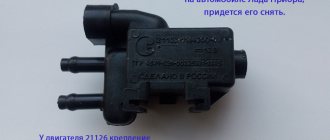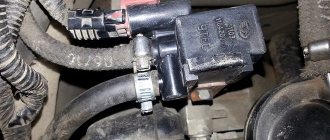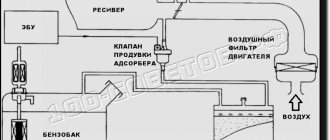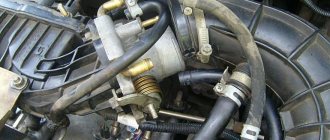In a car, the adsorber absorbs fuel vapor from the gas tank ventilation system and supplies it to the intake, because according to environmental standards, the gas tank must be isolated from the atmosphere.
From Wikipedia ;
Adsorber (from Latin ad - on, with and sorbeo - absorb) is a device for absorbing (thickening) a surface layer of a solid, called an adsorbent (absorber), of dissolved or gaseous substances, not accompanied by a chemical reaction. The adsorber is used in chemical, oil refining and other industries. The process occurring inside this apparatus is called adsorption.
Gasoline vapor filtration system. The diagram is quite conventional, but it reflects the essence. Gasoline vapor from the tank passes through a carbon filter, is cleaned and supplied to the inlet through a solenoid valve controlled by the ECU.
Now the first question is - why filter gasoline vapors if they still go into the intake? The answer is simple - adjusting the internal combustion engine control program by adding the nth number of clean air at the inlet is much easier than making adjustments based on the fuel-air mixture (gasoline vapor from the tank) of an unknown proportion.
And now the answer to the main question - why delete it? So, although some manufacturers claim that this device will have enough resources for the entire life of the car, we know that they are lying)
In general, over time, the adsorber becomes clogged and stops passing air. As a result, we get excess pressure in the tank, which interferes with the normal operation of the fuel pump. In the cabin (sometimes under the hood) we get a periodic smell of gasoline, the vapors of which are squeezed out of the ventilation tube. And the engine starts running on a rich mixture due to lack of air.
Now guess how our country solves this problem? That's right, most people simply throw out the adsorber and turn off the system as shown in the diagram:
A fuel filter from a carburetor classic is usually placed on the tube from the gas tank, and the solenoid valve, through which clean air should flow into the engine, is simply shut off with a bolt.
In the picture I already wrote that this is wrong and here’s why. This method of removing the adsorber only partially solves the problem. Yes, the smell of gasoline disappears, the tank is ventilated, but no air is supplied to the intake and the engine continues to run on a rich mixture.
And now the following diagram:
And now it already shows how it SHOULD be done. The same filter from the classics is put on the hose from the valve to the adsorber, which now serves as an air filter and prevents dirt from getting into the receiver. This is how the fuel-air mixture is brought to normal parameters.
Well, now a couple of visual photos of what it all really looks like:
Everything is clear here, one tube goes to the gas tank, the second through the valve to the engine.
Bottom part of the adsorber. There is a fitting for supplying air from the atmosphere so that a vacuum is not created in the adsorber.
So this is all done on my machine. I didn’t take a photo of the tube from the tank, it’s hard to get to it even without a phone
» How to remove
Lada 2110 PhiX › Logbook › Removing the adsorber on a VAZ 2110
Hi all! Today, I will tell you how to properly remove the adsorber on a VAZ 2110-12. First, a little background. It all started when one day I removed the locker from the rear left fender and saw frayed hoses clogged with dirt and some kind of container, which, as it turned out later, turned out to be a separator. Judging by the condition of the hoses, it was clear that the adsorber was not performing its function, but was just cracking the valve in vain. Even then, the first thoughts crept in about getting rid of this device. Recently, in connection with the transition to DBP, I had to switch to a sports engine management program, in which the adsorber is not involved. I still don’t understand whether the customizer considered it unnecessary to turn it on, or whether the firmware did not allow this, but one way or another, I decided to completely remove the adsorber from under the hood. The procedure for removing the adsorber is not complicated, but there are some aspects that you need to know.
Canister purge valve - check and replacement
Before performing work, familiarize yourself with the precautions for repairing the engine control system (see 8.4.1).
To complete the work you will need:
— multimeter (in voltmeter and ohmmeter mode);
1. We prepare the car for work (see 5, paragraphs 1 and 2).
2. Having released the latch, disconnect the wiring harness block from the canister purge valve.
3. Connect the negative voltage probe (to the car body).
4. Turning on the ignition, use a voltmeter to measure the supply voltage at terminal A of the wiring harness block (the pins are marked on the block).
The voltage at the terminal must be at least 12 V. If the voltage is not supplied to the block or it is less than 12 V, then the battery is discharged, the power circuit is faulty, or the ECU is faulty.
5. Use a Phillips screwdriver to loosen the clamp securing the hose to the canister purge valve.
6. Remove the hose from the valve nozzle.
If the hose on the nozzle is seated tightly and cannot be disconnected, then you can remove the valve from the adsorber and, by rotating the valve, remove the hose from it.
7. Using a screwdriver, remove the valve from the adsorber.
8. Apply 12 V voltage from the battery to the valve terminals (“+” to terminal A
, “-” to pin
B
).
When voltage is applied to the terminals, the valve should open with a characteristic click. The faulty valve must be replaced.
If the new valve does not have an o-ring, remove it from the old valve.
A damaged O-ring should be replaced.
Install the valve in the reverse order of removal.
Source
How to check the adsorber valve. On our VAZs
- Posted by Avto-blogger
- Date: November 1 at 20:42
The specific question is #8212; how to check the operation of the adsorber valve? This device is found on many new cars. It is designed to absorb excess carbon gases from the car's gas tank. Thus, this mechanism prevents the release of gases into the atmosphere. It was necessary to use a device of this type after the introduction of new restrictive Euro-3 and higher standards. When working properly, the car has a low level of pollutant gases in the exhaust, and there is also a slight reduction in fuel consumption. However, like any device, this engine element also tends to break. Failure can occur due to clogging of the adsorbent inside the absorber, as well as due to direct mechanical impact on the absorber body. In any case, problems begin when the engine operates...
First, a little definition.
The adsorber valve - essentially stands on a can that has activated carbon inside, is actually installed in the gas tank (or nearby, maybe in the power system) and absorbs excess gasoline vapors. This “can” absorbs them, condenses them and sends them back to the power system. But for proper and long-term operation it needs to be ventilated.
And now in more detail
How can I check the functionality of this device? An important element in the absorber is the valve. To understand the function, let's look at how the adsorber works. When the car is parked, a large amount of gasoline vapor can accumulate in its tank. Some of the vapor is caught by the recuperator, and the rest settles back into the tank. The part that was caught is sent to the adsorber. When the engine is running, the absorber valve closes and interrupts the access of vapors, now they are sent into the combustion chamber. Why is this necessary? When you start the car, our device prevents vapors from entering the exhaust manifold, thereby reducing the amount of harmful substances in the gas.
How to identify a problem at work?
The most common symptoms of malfunction include:
1) Sometimes the engine starts to run unstable at idle speed;
2) If clogged, you may feel a slight increase in fuel consumption;
3) The car engine does not start the first time when hot;
4) A noticeable loss of traction at low speeds. At higher speeds, the loss of torque is less sensitive.
Another common malfunction is the appearance of cracks in rubber plugs. Through these cracks (holes), additional air is sucked in, and as a result, leads to problems with the engine.
DIY crafts for car enthusiasts
In a car, the adsorber absorbs fuel vapor from the gas tank ventilation system and supplies it to the intake, because according to environmental standards, the gas tank must be isolated from the atmosphere.
From Wikipedia;
Adsorber (from Latin ad - on, with and sorbeo - absorb) is a device for absorbing (thickening) a surface layer of a solid, called an adsorbent (absorber), of dissolved or gaseous substances, not accompanied by a chemical reaction. The adsorber is used in chemical, oil refining and other industries. The process occurring inside this apparatus is called adsorption.
Gasoline vapor filtration system. The diagram is quite conventional, but it reflects the essence. Gasoline vapor from the tank passes through a carbon filter, is cleaned and supplied to the inlet through a solenoid valve controlled by the ECU.
Now the first question is - why filter gasoline vapors if they still go into the intake? The answer is simple - adjusting the internal combustion engine control program by adding the nth number of clean air at the inlet is much easier than making adjustments based on the fuel-air mixture (gasoline vapor from the tank) of an unknown proportion.
And now the answer to the main question - why delete it? So, although some manufacturers claim that this device will have enough resources for the entire life of the car, we know that they are lying)
In general, over time, the adsorber becomes clogged and stops passing air. As a result, we get excess pressure in the tank, which interferes with the normal operation of the fuel pump. In the cabin (sometimes under the hood) we get a periodic smell of gasoline, the vapors of which are squeezed out of the ventilation tube. And the engine starts running on a rich mixture due to lack of air.
Now guess how our country solves this problem? That's right, most people simply throw out the adsorber and turn off the system as shown in the diagram: A fuel filter from a classic carburetor is usually put on the tube from the gas tank, and the solenoid valve, through which clean air should flow into the engine, is simply turned off with a bolt.
In the picture I already wrote that this is wrong and here’s why. This method of removing the adsorber only partially solves the problem. Yes, the smell of gasoline disappears, the tank is ventilated, but no air is supplied to the intake and the engine continues to run on a rich mixture.
And now the following diagram: And it already shows how it SHOULD be done. The same filter from the classics is put on the hose from the valve to the adsorber, which now serves as an air filter and prevents dirt from getting into the receiver. This is how the fuel-air mixture is brought to normal parameters.
Well, now a couple of visual photos of what it all really looks like: Everything is clear here, one tube goes to the gas tank, the second through the valve to the engine.
Enter your email and receive emails with new crafts.
Bottom part of the adsorber. There is a fitting for supplying air from the atmosphere so that a vacuum is not created in the adsorber. So this is all done on my machine. I didn’t take a photo of the tube from the tank, it’s hard to get to it even without a phone
Popular;
- How to check the quality of purchased gasoline?
- If the gas cap hisses when opening and not only
Factory car painting. How does this happen?- Do-it-yourself additional cleaning of car oil
Features of ESP operation- Minor alteration of the blowtorch
- Refilling the air conditioner with your own hands
- How to apply wax to a car
And now in more detail
How can I check the functionality of this device? The fundamental element in the absorber is the valve. To understand the function, let’s look at how the adsorber works. When a car is parked, a huge amount of gasoline vapor can accumulate in its tank. Some of the vapor is caught by the recuperator, and the rest settles back into the tank. The part that was caught goes into the adsorber. When the engine is running, the absorber valve closes and interrupts the access of vapors, now they are sent to the combustion chamber. What is it for? When you start the car, our device prevents vapors from entering the exhaust manifold, thereby reducing the amount of harmful substances in the gas.
Work principles
Fuel typically evaporates, and in sealed containers like a tank, the evaporation builds up pressure. From the tank, vapors go to the separator, condense and return back to the tank, excess vapors are sent to the adsorber, where the active element absorbs them.
If you have ever stored gasoline in a canister, you have seen how it swells during long-term storage; if you are not so lucky, you could see how it “explodes,” usually on the lid, but on plastic canisters the weakest point is not determined by the lid.
This is what this process looks like when the engine is turned off, when the engine is running, the system opens the adsorber valve (purge valve), when the valve is open, the vapors do not reach the absorber, but are directly blown into the intake pipe, where the engine successfully burns them.
This algorithm is designed to obtain two advantages of the system:
- Increasing the environmental friendliness of the car due to the absorption of fumes.
- Fuel economy when driving (savings are 1%, but present).
As we figured out, gasoline vapors are absorbed by the adsorber or blown into the intake valve, which is responsible for changing operating modes and controlling the system. It switches during system startup, thanks to the engine start controller; during ignition, it turns on the receiver, the sorbent is purged and unabsorbed vapors are immediately sent to the engine, saving every milligram of evaporated fuel.
In addition to the above advantages, the system also does not allow the smell of gasoline into the lard of the car, but such a system also has disadvantages (albeit controversial), motorists complain that it:
- takes up space under the hood;
- is the culprit of unstable operation when broken;
- Expensive.
Signs of a malfunctioning adsorber
- Uneven acceleration of the car;
- Fuel tank indication failures;
- A characteristic whistle when opening the tank lid;
- Increased fuel consumption;
- Tapping the engine when cold;
If such symptoms occur, we recommend that you contact your nearest diagnostician to determine the exact cause of the malfunction and subsequent repairs.
Clicking canister valve
If the adsorber valve operates with clicking, clicking sounds, or simply knocks, the first thing you need to do is make sure that the noise comes from it and not from other elements (rollers, timing belt, etc.). A common method of checking is to sharply depress the gas pedal, and if the sound does not change, then most likely this is the problem. This sound often appears in sub-zero weather. In this case, you need to contact a specialist to diagnose the EVAP system.
Canister valve on Lada Vesta: sometimes the clicking noise can be eliminated by adjusting the screw.
FakeHeader
Comments 8
About the effective fight against omissions by eliminating the serial factory circuit jamb www.drive2.ru/b/480194662074679487/
As you write, I’m inclined to think about bad firmware. And you tell me how you fixed the problem with the coil. Not logical. I am a private user of the Icebreaker firmware and recognize it as better than the factory one. Which I am not imposing. But traction is better, consumption is less (by 1.5 liters). Maybe the factory one will be better on your gasoline? (Because the main difference, let’s say, is the quality of the fuel) theoretically it can. In practice, I see more grateful reviews. I understood what I could do with the adsorber. Thanks for the tip!
avtoexperts.ru
What is an adsorber, what task does it perform, what problems can arise, we’ll talk about this and much more in today’s article.
Many car owners have no idea, let alone the structure of the system, and sometimes even its existence. Therefore, the goal of this article is to “put everything into perspective,” including finding out how the device works, as well as where it is located.
Why do you need an adsorber?
It was originally created as a tribute to environmental standards, more precisely under EURO2. By and large, the motor can be configured so that it can do without it. But, taking into account modern standards, vapor leaks are unacceptable. Plus, the adsorber does not allow fuel vapors to enter the cabin, which, as you understand, is also unpleasant. If on old cars, still of the carburetor type, such a system did not exist, in principle, on all modern injectors, it is mandatory.
